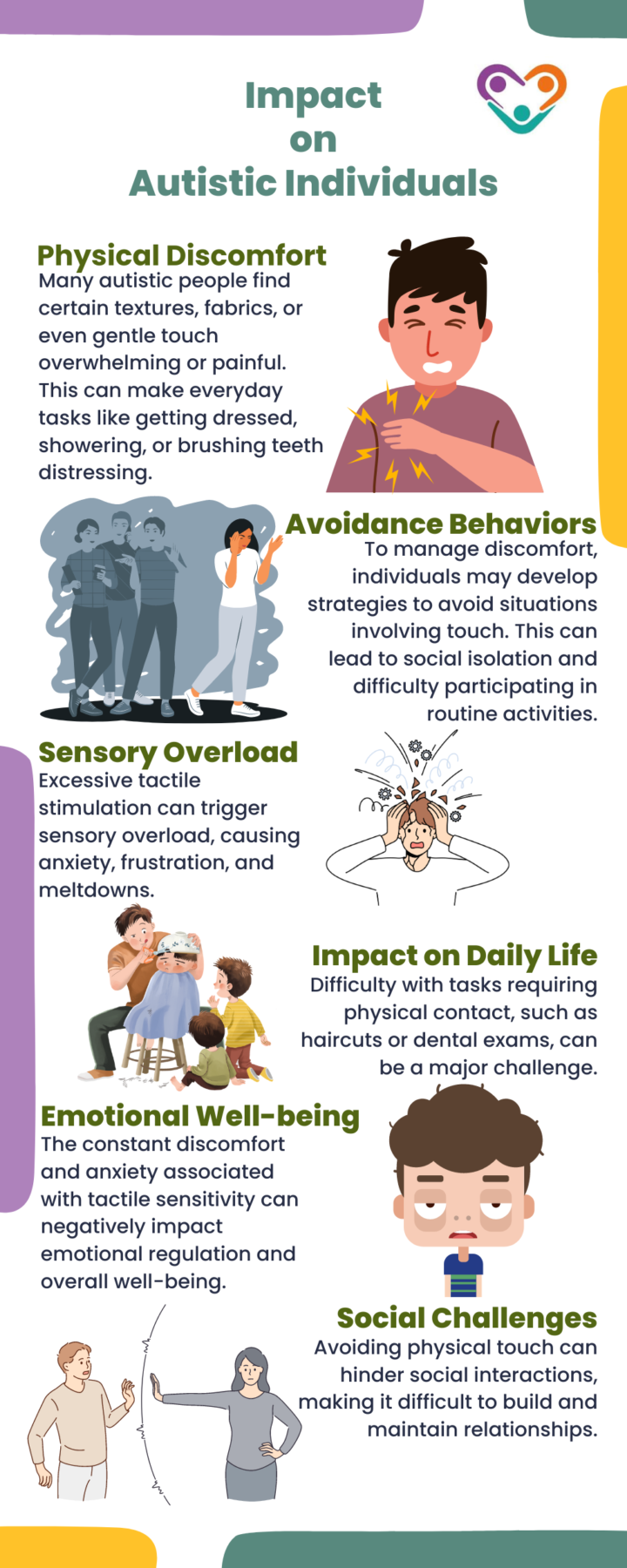Tactile sensitivity, or hypersensitivity to touch, is a common challenge faced by individuals with autism. This heightened sensitivity can significantly impact daily life, causing discomfort, anxiety, and even avoidance of certain activities.
Understanding Tactile Sensitivity
Tactile sensitivity, a symptom of hyperesthesia, is a heightened awareness or sensitivity to touch. Unlike most people who find touch comforting or neutral, individuals with tactile sensitivity may experience certain textures or even gentle physical contact as uncomfortable, overwhelming, or painful.
This heightened sensory response can significantly impact daily life, making routine tasks and social interactions challenging. Imagine having a constant low-level irritation on your skin, intensified by certain stimuli. This is what tactile sensitivity can feel like.
It’s as if the sense of touch is amplified, making ordinary sensations overwhelming. This heightened sensitivity can vary in intensity and can affect different parts of the body. While it’s often associated with autism, tactile sensitivity can occur in people without autism.
Other conditions, such as obsessive-compulsive disorder (OCD) and attention deficit hyperactivity disorder (ADHD), can also be linked to heightened sensory experiences. Additionally, medical conditions like neuropathic pain or certain medications may contribute to tactile sensitivity.
Understanding the complexities of tactile sensitivity is crucial for providing appropriate support to individuals who experience it. By recognizing and validating their sensory experiences, we can create a more inclusive and understanding environment for them.
The Impact on Autistic Individuals
Tactile sensitivity can significantly disrupt the lives of autistic individuals. This heightened sensitivity to touch can manifest in various ways.

Understanding the specific ways tactile sensitivity affects autistic individuals is crucial for providing appropriate support and accommodations.
Research Findings
To better comprehend the complexities of tactile sensitivity in autism, researchers have delved into how individuals with autism perceive and respond to touch. Studies have shown that tactile perception is often altered in people with autism, particularly in early childhood.
For instance, autistic children tend to have higher thresholds for distinguishing between different touch sensations and determining the order of tactile stimuli compared to neurotypical peers. This suggests that their brains process touch information differently. Additionally, they may react more slowly or inconsistently to touch, indicating potential challenges in perceptual-motor processing.
However, it’s essential to note that the research landscape is varied, with findings ranging from heightened to reduced tactile sensitivity. This highlights the diverse nature of autism and the need for more comprehensive research.
Psychophysical studies have shed light on specific differences in how individuals with autism perceive touch. These studies have linked altered tactile perception to lower levels of a brain chemical called GABA, which plays a crucial role in inhibiting neural activity. This finding supports the theory that an imbalance between excitatory and inhibitory brain processes contributes to autism.
Beyond altered perception, people with autism frequently exhibit unusual responses to sensory input, including touch. More than 90% of autistic children experience either overly sensitive or under-sensitive reactions to sensory stimuli. These sensory differences are core characteristics of autism and significantly impact daily life.
Understanding these intricacies of tactile perception and sensory responses is vital for developing effective support strategies. By recognizing and addressing tactile sensitivities, we can create environments that are more comfortable and accommodating for individuals with autism.
While research has made significant strides, there’s still much to uncover. Standardizing terminology to describe sensory differences is crucial for advancing research and improving communication among experts.
Furthermore, exploring the underlying neural mechanisms of tactile sensitivity in autism holds immense potential for developing targeted interventions. By continuing to investigate these areas, researchers can contribute to enhancing the lives of individuals with autism.
Treatment and Management
Managing tactile sensitivity in autism requires a multifaceted approach. While tactile sensitivity is often a symptom of autism, it’s essential to rule out other potential medical conditions.
A comprehensive evaluation by healthcare professionals can help identify any underlying issues, such as sensory processing disorder, neuropathic pain, or other neurological conditions.

Coping Strategies for Tactile Sensitivity
Many effective coping strategies can help individuals with autism manage tactile sensitivity and navigate their sensory world with greater comfort. These strategies can be broadly categorized into environmental modifications, sensory input techniques, and therapeutic interventions.
- Creating a Sensory-Friendly Environment: Modifying surroundings to reduce overwhelming sensory input can be beneficial. This includes using soft textures, minimizing noise, and controlling lighting.
- Deep Pressure Input: Providing deep pressure can help regulate sensory input and promote calmness. Techniques include weighted blankets, deep-pressure massages, or compression clothing.
- Gradual Desensitization: Slowly introducing a variety of textures can help individuals become more tolerant of touch. This should be done in a controlled and supportive environment.
- Sensory Breaks: Allowing regular breaks in sensory-rich environments provides an opportunity to recharge and reduce sensory overload.
- Sensory Tools: Fidget toys, chewable jewelry, or textured objects can offer alternative sensory input and provide comfort.
- Occupational Therapy: Occupational therapists specialize in helping individuals develop skills for daily living. They can provide strategies and techniques to manage tactile sensitivity.
Individualized Approach
It’s also crucial to remember that every individual with autism is unique. What works for one person may not work for another. Collaborating with healthcare providers, therapists, and educators can help develop a personalized treatment plan that addresses the specific needs of the individual.
By combining these strategies and working closely with professionals, individuals with tactile sensitivity can learn to manage their symptoms and improve their overall quality of life. Consider exploring ABA therapy as a valuable tool for addressing sensory challenges.
Golden Care’s team of experienced professionals offers ABA therapy in NYC, Indiana, New Jersey, Georgia, and Florida. We provide personalized care and evidence-based interventions to help individuals with autism reach their full potential. Contact us today to learn more about how we can support you and your family!



